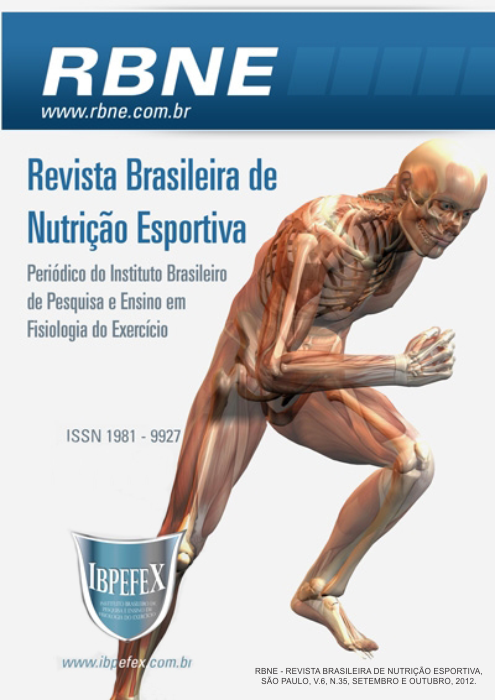Profile dietary, nutritional status and level of physical activity in practitioners of physical exercise of academies of Vitória da Conquista-BA
Abstract
Objective: To assess the dietary profile of practice exercises frequenting gyms. Methods: The sample included 337 individuals male and female. We used recall was 24 hours. To assess the level of physical activity were used Sapaf software. Nutritional status was measured by body mass index (BMI) and waist circumference (WC). Results and discussion: There was a predominance of male subjects, white, unmarried, with incomplete higher education, family incomeof more than 3 to 10 minimum wages, and who attend the academy in a period longer than 12 months. The average showed age of 27.98 ± 10.99, BMI 23.99 ± 3.73. In relation to food consumption, the averages were: VCT 2618.13 ± 1244.20 kcal, PTN 18.42% ± 6.14,56.55 ± 9.74% CHO, 24.87 ± 8.02% LPD. The average total caloric expenditure (Ideal Weight) was 2789.51 ± 621.92. Nutritional status, 69% are eutrophic, 22% were overweight, 6% are obese and 3% underweight. According to CC, 83.7% are without risk of obesity associated with metabolic changes. The comparison of means by gender showed that men consumed higher amounts of protein (p = 0.012) when compared to women. Completion: the study suggests the involvement of dieticians for nutrition guidelines that are made to bring about balanced diet and safe in order to maximize the effects of physical activity.
References
-Associação Brasileira de Academias. 2004. Disponível em: http://www.acadbrasil.com.br/portal/revista/pdf/revista_18.pdf. Acesso em: 02/03/2010.
-Brasil. Conselho Nacional de Saúde. Resolução CNS nº 196/1996. Diretrizes e normas regulamentadoras de pesquisas envolvendo seres humanos. Disponível em: http://conselho.saude.gov.br/resolucoes/reso_96.htm. Acesso em: 05/06/2011.
-Caparros, D.R.; Stulbach, T.E.; Nunes, D.C.; Del Doltore, C.P.; Rodrigues, V.C.J.; Barros, A.Z. Ingestão protéica de praticantes de musculação de uma academia do município de Santo André. Rev Digital Efdeportes. Buenos Aires. Ano 14. Núm. 132. 2009.
-Coelho, C.F.C.; Camargo, V.R.; Ravagnani, F.C.P. Consumo de Suplementos Nutricionais por Praticantes de Musculação em Academias de Campo-Grande -MS. Nutrição em Pauta. São Paulo. Vol. 15. Núm. 87. p. 41-45. 2007.
-Duarte, A.C.G.D.; Castellani, F.R. Seminologia Nutricional. Rio de Janeiro. Axcel Books.2002.
-Duran, A.C.; Latorre, M.R.D.O.; Florindo, A.A.; Jaime, P.C. Correlação entre o consumo alimentar e nível de atividade física habitual de praticantes de exercícios físicos em academia. Rev Bras Ci. e Mov. Brasília. Vol.12. Núm. 3. p. 15-19. 2004.
-Fernandez, M.D.; Sainz, A.G.; Garzon, M.J.C. Treinamento físico-desportivo e alimentação: da infância à idade adulta. 2ªedição. Porto Alegre. Artmed. 2002.
-Friedman, J.E.; Lemon, P.W.R. Effect of chronic endurance exercise on retention of dietary protein. Int. J. Sports Med. Vol. 10. p. 118-123.1989.
-Hirschbruch, M. D.; Carvalho, J. R. (Org.). Nutrição esportiva: uma visão prática. 2ªedição. São Paulo. Manole.2008.
-Isensee, M.; Riciardi, P.M.; Testa, P.; Kasapi, I.M. O que Ciclistas Devem e Podem Consumir Antes, Durante e Após Atividade Física: Sugerindo Preparações. Nutrição em Pauta. São Paulo. Vol. 16. Núm. 89. p. 49-52. 2008.
-Kleiner, S.M.; Greenwood-Robinson, M. Nutrição para treinamento de força. 3ªedição. Barueri. São Paulo. Manole. 2009.
-Lancha Junior, A.H. Nutrição e metabolismo aplicados a atividade motora. São Paulo: Atheneu, 2002.
-Lemon, P. W. R. Effect of exercise on protein requirements. J. Sports Sci. Vol. 9. p. 53-70. 1991a.
-Lemon. P.W.R. Protein and amino acid needs of the strength athlete. Int J Sport Nutr. Vol. 1. p. 127-145. 1991b.
-Lemon, P.W.R. Protein requeriment of soccer. Journal of Sports Science, London, Vol. 12. p. S17-S22. 1994.
-Lemon, P.W.R.; Mullin, J.P. Effect of initial muscle glycogen levels on protein catabolism during exercise. Journal of Physiology. Vol. 48. p. 624-629.1980.
-Lemon. P.W.R.; Proctor, D.N. Protein intake and athletes performance. Sports Med. Vol. 12. p. 313-325. 1991.
-Lemon, P.W.R.; Tarnopolsky, M.A.; MacDougall, J.D.; Atkinson, S.A. Protein requirements and muscle mass/ strenght changes during intensive training in novice bodybuilders. J. Appl. Physiol. Vol. 73. p. 767-775. 1992.
-Lemon, P.W.R.; Nagle, F.J.; Mullin, J.P.; Benevenga, N.J.In vivo leucine oxidation at rest and during two intensities of exercise. J Appl Physiol. Vol. 53. p. 947–954. 1982.
-Mcardle, W.D.; Katch, F.I.; Katch, V.L. Nutrição Para o Desporto e o Exercício. Rio de janeiro: Guanabara, 2001.
-Nacif, M.; Viebig, R.F. Avaliação Antropométrica nos Ciclos de Vida: uma visão prática. São Paulo: Metha, 2008. 137 p.
-Organização Mundial daSaúde-OMS. Obesidade. Impedindo e controlando a epidemia global. Genebra. 1997. p. 107-158.
-Pereira, J.M.; Cabral, P. Avaliação dos conhecimentos básicos sobre nutrição de praticantes de musculação em uma academia da cidade de Recife. Rev Bras de Nutrição Esportiva. São Paulo. Vol. 1. Núm. 1. p. 40-47. 2007.
-Rocha, L.P. da; Pereira, M.V.L. Consumo de suplementos nutricionais por praticantes de exercícios físicos em academias. Rev Nutr. Vol. 11. Núm. 1. p. 76-81. 1998.
-Tirapegui, J. Recomendações para a prática esportiva. Rev Nestlé Bio Nutrição e Saúde. São Paulo. ano 2. Núm. 3. 2007.
-Triola, M.F. Introdução à Estatística. 7ªedição. Rio de Janeiro. LTC. 1998.
-World Health Organization. Obesity. Preventing and Managing the Global Epidemic. Report of a WHO Consultation on Obesity, Geneva. World Health Organization.1997. p. 107-158.
Authors who publish in this journal agree to the following terms:
- Authors retain the copyright and grant the journal the right of first publication, with work simultaneously licensed under the Creative Commons Attribution License BY-NC which allows the sharing of the work with acknowledgment of the authorship of the work and initial publication in this journal.
- Authors are authorized to enter into additional contracts separately for non-exclusive distribution of the version of the work published in this journal (eg, publishing in institutional repository or book chapter), with acknowledgment of authorship and initial publication in this journal.
- Authors are allowed and encouraged to post and distribute their work online (eg, in institutional repositories or on their personal page) at any point before or during the editorial process, as this can bring about productive change as well as increase impact and impact. citation of published work (See The Effect of Free Access).






